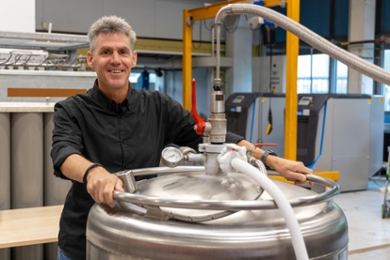
White clouds of ice-cold gas flowing across the floor. Magical, but be careful not to freeze your fingers off. We are of course talking about liquid nitrogen and helium. You may have seen the spectacular Freezing Physics science show by the student organisation Rino. But did you know that this commodity is also crucial for a lot of research? Thanks to cryogenic technician Wilfred van der Geest, it is always available.

With the ease of years of experience, he syphons the cold liquid into a large metal vessel. Van der Geest single-handedly manages the cryogenics department, from production, dispensing and maintenance to user instruction. And has been doing that for more than 35 years. 'My challenge is to make sure that liquid helium is available to researchers any day, any time. I have never had to shut down a research setup.' And that's not a given. In fact, a lot of work goes into it.
Physicists, chemists, or biologists at NeCEN: they all need Van der Geest. 'Though fortunately I have support from colleagues in the Fine Mechanical and Electronics Department when I'm on vacation,' he says. 'A lot of research is done at extremely low temperatures and should not heat up in between. Liquid helium is a lot colder than liquid nitrogen, close to absolute zero.'
Production cycle of liquid helium
Helium gas is stored under high pressure. Any impurities are taken out in the so-called purifier and then it is liquefied - and thus made ice cold. Then the liquid is transferred into transport vessels and brought to research setups scattered throughout the faculty. Each time it is syphoned, there is about ten percent loss that immediately evaporates. This is captured and returned to the installation through a network of pipes, where the cycle starts again. To offset the losses, gas is occasionally purchased from an external partner.
An entire career at the university
'This is a unique job, hardly anyone does this work,' Van der Geest says enthusiastically. As a newly graduated technician, he ended up at the university by chance. 'And I never left. My job is incredibly fun. Every day I meet new people from all kinds of fields and from all parts of the world.'
'We always decided to invest in our own production, which is now bearing fruit.'
He can also keep innovating. During his career, he has completely modernised and automated the installation. He coordinated the move from the KOG to the Huygens Building, and the next move to the Gorlaeus Building is already in the pipeline. 'I've seen a lot of changes and there is a new challenge every time. That keeps my job interesting.'
Liquid helium is running out
Many universities have stopped their own production in recent years and purchase all their liquid helium from companies. That creates challenges, according to Van der Geest. 'The price of liquid helium is skyrocketing. Then they sometimes regret their decision. For example, a lot of helium came from the U.S. and they don't supply it anymore. Or from Russia, which we no longer cooperate with. In Leiden we always decided to keep doing it ourselves and invested in that, which is now bearing fruit.'

'We also notice now that there is simply less helium available, because it is a byproduct of fossil fuel production. That is not infinite and therefore declining,' he adds. 'For a long time it was every person for themself, because you didn't need each other. But now we are contacting other universities to see how we can find a solution for the future together.'






